
If you’re shopping for trombones, but aren’t quite sure what you’re looking for…
Or how to tell the difference between one model and the next…
You’ve come to the right place.
Because in this ultimate guide, you’re about to get a crash-course in everything a new player would care to know, when first getting started with this instrument.
First up…
Tenor Trombones vs the Rest…

You may not know is…but there are actually around a DOZEN different types of trombones in existence.
So just to clarify for the sake of this article, we’ll be focusing exclusively on the tenor trombone…
Because it’s what 99% of players play, and what musicians commonly refer to simply as the “trombone”.
Up next…
Small vs Large Bore Trombones
The bore size refers to the diameter of the slide of the trombone.
- Large bore trombones (.547″) – aka symphonic trombones
- Small bore trombones (.480″ to .508″) – aka jazz trombones
To get an idea of how they sound, check out this clip:
There 2 more bore optios that are less common but still relevant. These are:
- Double bore – which are a special type of trombone that uses 2 different bore sizes, smaller on the mouthpiece tube and larger on the other tube. This provides more advanced players with a broader sound.
- Medium bore (.525″) – which are popular with first chairs in orchestras and shows (musicals/pit orchestras…) and many other players who appreciate their versatility. The Bach 36 is particularly popular since it offers a sound many “pit” musicians – that is trombone players playing in medium groups of 8 to 15 musicians – find to be just perfect.
- Bach 36B Stradivarius Series: (Amazon)
Next up…
Anatomy of the Trombone
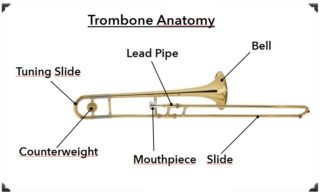
While the trombone has many different parts…
There are really only 5 major parts you need to know when weighing your purchase options.
So we’ll cover each these, one by one, right now.
Starting first with…
PART #1: The Trombone Mouthpiece
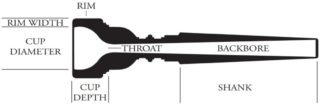
You wouldn’t think a mouthpiece would be too complicated…
But as you can see in the image, it actually has several parts, each of which come in different size options.
So here’s what you should know about each these parts:
The Shank
The shank is the piece fits into the mouthpiece receiver. Since receivers come in different “bore sizes”, you’ll need to make sure your shank size matches.
The Rim
The rim is the part of the mouthpiece that touches your lips. Wide round rims are easier to play, while narrow sharp rims offer more sound options.
The Cup
The cup is the size and shape of the mouthpiece opening.
- Deeper cups create dark tones in the low register, while shallower cups create a brighter tone and quicker response.
- Wider cups offer more volume and sonic control, while narrower cups offer more comfort and endurance.
The Throat/Backbore
The throat is the narrow space that follows the cup. And the backbore is the wider that follows the throat. As a general rule of thumb
- Narrow/long = faster response, and a brighter tone
- Wide/short = darker tone, and more effort to play.
So that covers the mouthpiece. Moving on the next part of the trombone…
PART #2: The Trombone Leadpipe
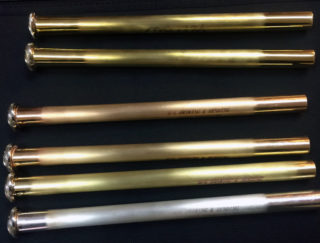
Immediately following the mouthpiece, we have the leadpipe.
The only major concern with this piece, is making sure its bore size matches that of the mouthpiece shank.
They also come in 3 lengths: standard, short, and long. The longer the piece, the more centered the sound.
And finally there’s the metal alloy, which has 4 common options:
- Gold Brass – warmest sound
- Nickel Silver – clear and crisp sound
- Sterling Silver – strong attack and fundamentals
- Yellow Brass – most balanced sound/most popular choice
Up next…
PART #3: The Trombone Slide

The slide is the signature piece of the trombone, used to change its pitch, by changing the tube length.
This one piece makes it the ONLY brass instrument capable of sliding between notes, and is primarily responsible for its iconic sound.
The slide is comprised of 2 elements:
- The inner slide – which is stationary
- The outer slide – which moves over the inner slide
To play properly, the space between tubes needs to be .1mm. At just 0.2mm the instrument is unplayable.
The only portion where the slides actuall touch is at the stocking, which you can see in the image above.
Up next…
PART #4: The F Attachment
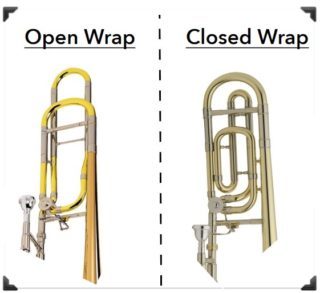
The F attachment, aka the quart valve or trigger is a key that, when pressed…
Opens up extra tubing so as to lower the fundamental pitch from Bb to F.
This allows the player to 7th position notes more easily, from a closer hand position.
This can be built either through an open or closed wrap design. Closed wrap design have more tube bends and are therefore smaller. While open wraps have less bends, and are therefore, larger, but also more playable.
Check out the video below to see how it works:
Next up…
PART #5: The Trombone Bell
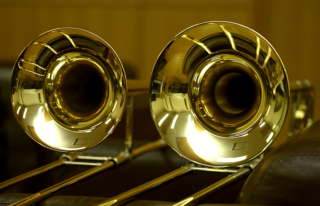
The bell is essentially the amplifier of the trombone. And its size and shape can vary in a number of ways:
- Diameter – Small bore trombones have smaller diameters than large bore. Diameters generally vary between 6 1/2″ and 10 1/2″.
- Thickness – large bore trombones are generally thicker, with a warmer sound.
- Brass Alloy Mix – more copper in the brass generally means a warmer sound a low volumes, and a brighter sound at high volumes. Common alloys include:
- Red Brass (90% brass/10% zinc)
- Gold Brass (85% brass/15% zinc)
- Yellow Brass (70% brass/30% zinc)
- Sterling Silver
- One/Two Piece – the bell and spout can come as a single piece or be soldered together (sound difference is negligible)
- Taper – slow tapers sound brighter/fast tapers sound warmer
- Wire Bead – which can either be soldered to the bell edge, or not.
Up next…
Our Top Recommendations for Buyers
At this point you have everything you need to know to make an informed decision when buying a trombone. But to make things even easier for you, here’s a list of our top recommended options:
Under $1000
- Mendini by Cecilio Tenor Trombone – (Amazon)
- Jean-Paul USA Student Trombone – (Amazon)
- Selmer Prelude – (Amazon)
- Michael Rath John Packer Trombone – (Amazon)
- Jupiter Standard Series – (Amazon)
- Roy Benson RBTT242F – (Amazon)
Over $1000
- Bach 42BO Stradivarius Series – (Amazon/Thomann)
- S.E. Shires Q Series – (Amazon)
- Bach 42AF Stradivarius Series – (Amazon/Thomann)
- Conn 88HO Symphony Series – (Amazon/Thomann)
Up next…
The pBone Plastic Trombone for Kids
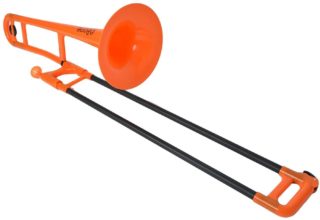
The pBone is a plastic trombone manufactured by a British company of the same name.
While it’s clearly not a choice for professionals, it’s an extremely affordable and practical choice for anyone new to the instrument…particularly kids.
Here’s a comparison of how it sounds next to a regular trombone.
- The pBone Mini – the smaller option for kids as young as 4.
- The Jiggs pBone – the standard option
Check them out:
Up next…
3 Must-Have Trombone Accessories
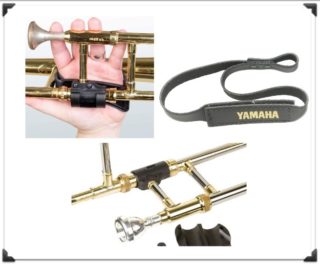
With this instrument, there are 3 accessories which are particularly useful:
- Support systems – which make it easier to hold the trombone for longer periods of time.
- Mutes – which are used to lower the volume of the instrument, either for stylistic choices, or quieter practice.
- Cases – which are obviously used for transport.
So here the top models I recommend for each of these important accessories :
Support Systems
- Neotech Trombone Grip – (Amazon/Thomann)
- Neotech Straight Brace – (Amazon)
- Yamaha Hand Strap – (Amazon)
Mutes
- Solo Bucket Mute – (Amazon/Thomann)
- Dennis Wick Straight Mute – (Amazon/Thomann)
- The Yamaha Silent Brass System – (Amazon/Thomann)
- Bremner SshhMute – (Amazon)
- Protec Liberty Practice Mute – (Amazon)
Cases
- Andoer Gig Bag – (Amazon)
- Gator Polyfoam Case – (Amazon)
- Protec MX306CT molded-interior case – (Amazon)
- Protec IP306CT wood frame case – (Amazon/Thomann)
- Protec Platinum Series Case – (Amazon/Thomann)
So that concludes this ultimate guide. I hope you found it useful.
By the way, if you found this post useful, I highly recommend joining our free Home Recording Secrets email newsletter where you’ll discover….
- How to Get Your First Studio Up and Running in a Single Weekend
- How to Avoid Wasting Thousands of Dollars on Unnecessary Pointless Purchases
- How to Get a “Million Dollar” Pro Studio Sound in a “Thousand Dollar” Home Studio
- PLUS… All Sorts of Other Amazing Insider Secrets Revealed
And it’s totally FREE! Click here and Enter Your Email to Sign Up.